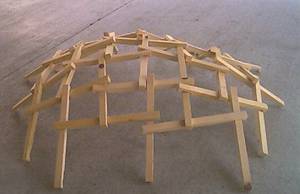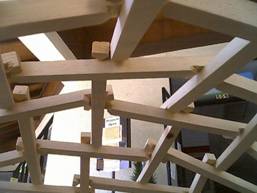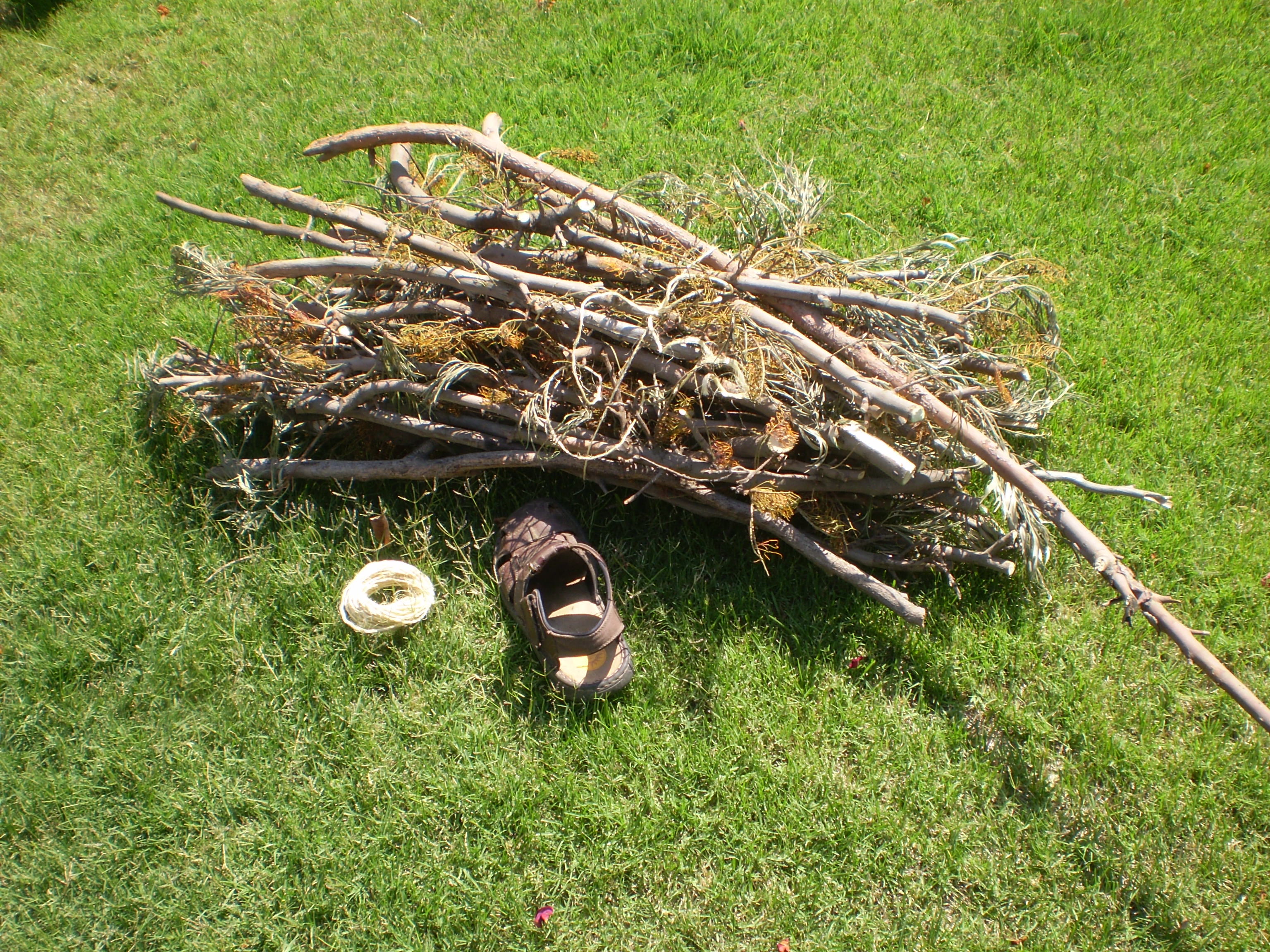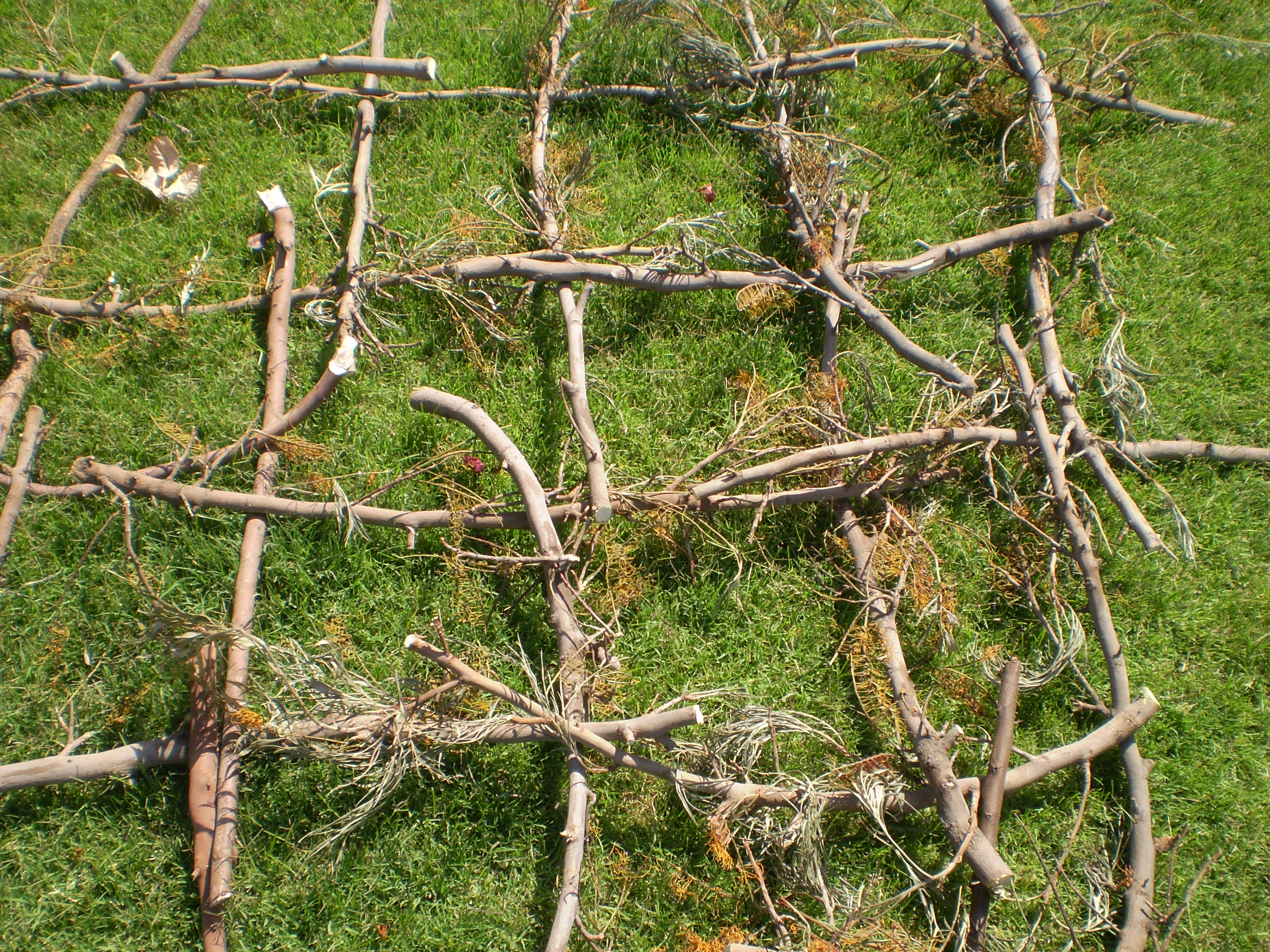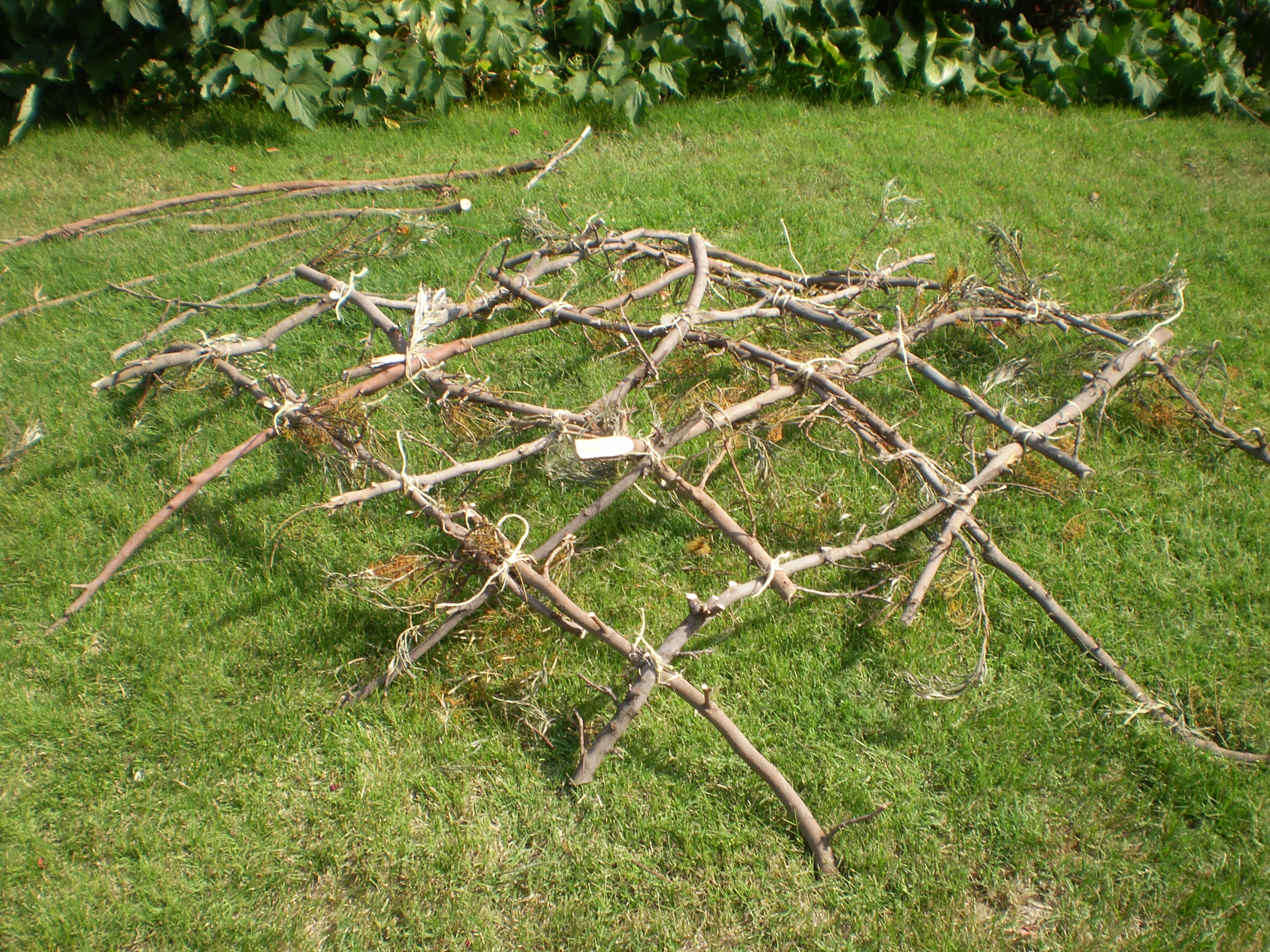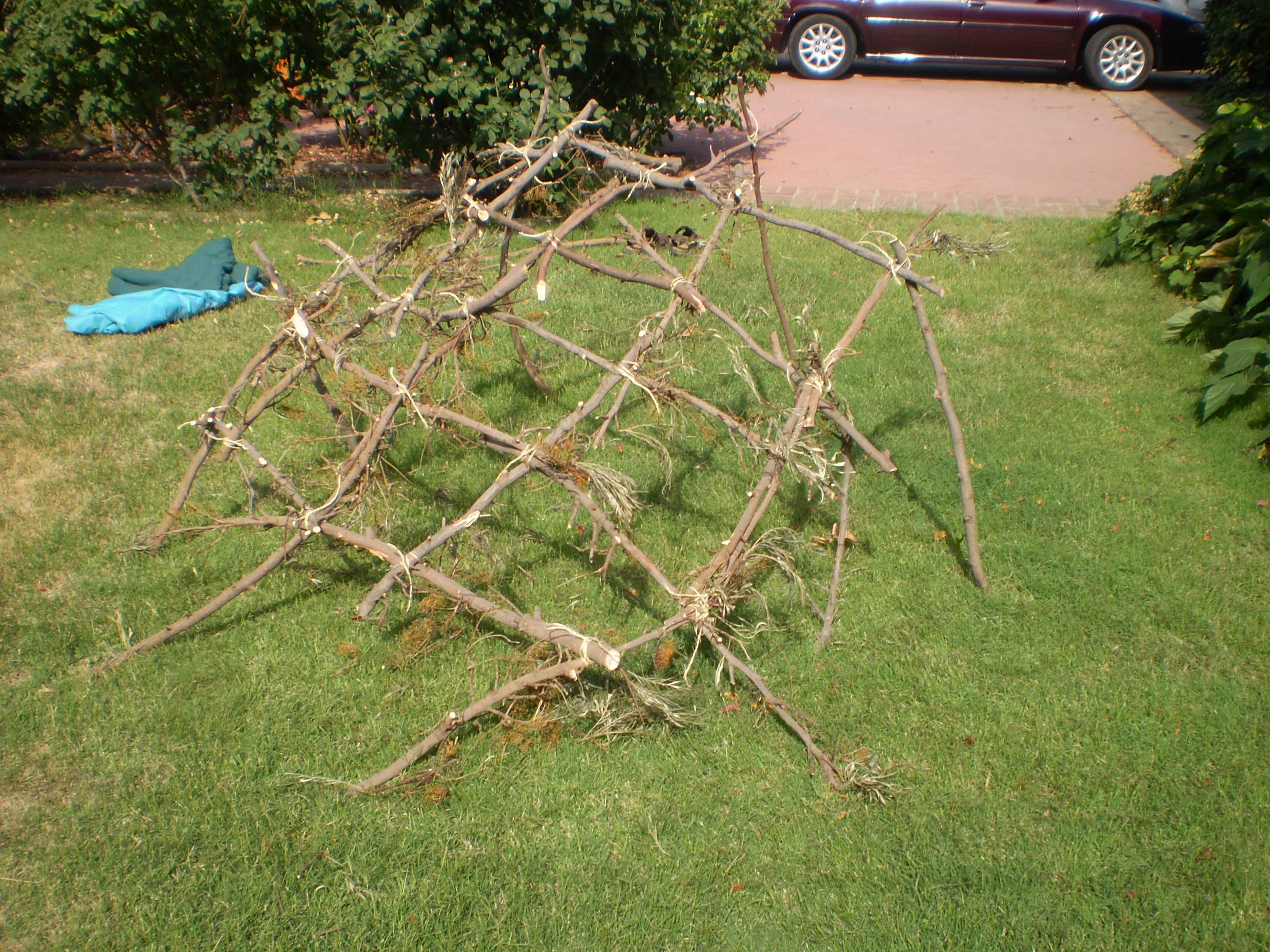Emergency
Shelters
The first choice for
a fresh-after-the-emergency shelter may well be a car or truck, or
even a commercial camping tent. I even spent one night in a crude
hammock I formed from part of a parachute.
I actually lived in a
Volkswagen van for awhile while working and going to school. It was
uncomfortably close, but doable. I found myself eating out and going
to the library a lot just for the space and company, but at least I
never forgot anything when I went anywhere. In the absence of an
available vehicle however, consider the following:
An author named Tom
Brown devised a survival shelter that consisted of a pile of leaves
covered by branches, and whatever scraps he could find that might
assist in thatching. Slither into the nest of leaves and enjoy a snug
night with whatever else might slither in. Plastic bags of dry leaves
or soft dry trash can also provide emergency insulation.
During a phase of my
life when a motorcycle was very important to me I folded a blanket in
a 6’ X 10’ tarp and sat on it as I traveled. With the
tarp folded over me, my jacket “horseshoed” around my
head and shoulders, and the blanket used (or not), I could sleep warm
and dry wherever the wind would carry me.
Sometimes a level of
concealment is advisable. Generally speaking, there is no legal place
for homeless people to exist. I remember seeing a security guard
ordering a crippled homeless man to move on, and his response was
“Tell me where to move to and I’ll gladly go.” I
used to walk past one homeless camp nestled among piles of earth that
had been dumped on vacant land. One winter morning the area had been
bulldozed – merry Christmas non-existent ones. For more on this
category of existence see
Stealth. On
a couple of occasion I and a group of friends wanted to enjoy a small
fire (a no-no on upscale Southern California beaches). We dug out a
pit a little over 8 feet in diameter by about 18” deep and
enjoyed a cozy circle around a small bed of coals. When a helicopter
patrolled overhead, a couple of us would stand over the coals to
conceal it from view.
On another beach we
dug a slightly larger and deeper hole. When patrol Jeeps would
approach, we would nonchalantly move off a little ways and return a
couple minutes later. Jeeps passing about 30’ away ignored it –
they’d seen sand excavations before. Later that night, while a
couple of us were sleeping a safe distance from Jeep routs, one of
the Jeeps fell in. After about thirty minutes of very creative
profanity they were safely on their way. This was cool, we’d
never caught a whole jeep before.
On more serious level, such an
excavation could serve on freezing evenings to conceal a small fire.
In some cases such an excavation might be partially covered by a
low-profile dome. Sometimes a homeless person will stay up and walk
around all night to keep warm, rather than risk falling asleep and
freezing.
I once built a 23’
diameter low-profile dome out of various scraps in Colorado to keep
snow off of a group of homeless. There was a landowner compassionate
enough to allow a site, but city officials made them tear it down.
For some, their
situation is due to circumstances they could not control. They are
true victims of societal failure. Others among them will admit that
they are there because of their own poor choices in life. And there
are others still who are living in obscurity because they have
warrants out for their arrests – real victims, real failures,
and real criminals. But in any case their pain is also real. Have a
heart.
Here is how you can
build a structure from almost any sticks you can find, and they don't
even have to be exactly the same length.
There's only one rule
to putting it together: The end of each stick rests upon the center
of another stick (except for ends that may be resting on the ground).
For additional security, it doesn't hurt to tie or wire the ends in
place.
This technology
offers an opportunity for those who have no option but to live
outside. If they have the blessing of at least owning a tent, two or
three months of full sunshine and constant use is likely to seriously
damage it. By building a canopy using this structure, and covering it
with anything that could be found or recycled, shade could be
provided to protect a tent from sunlight.
If scraps of water-resistant materials
could be found it could be “shingled” to protect it from
rain, so it could provide living space to reduce wear on the tent. In
a more dire situation, it could become the emergency shelter in
itself,
To demonstrate the
minimal level of materials needed for a basic structure, I salvaged
twigs from a branch that had fallen on a friend's shop. The photo
below shows the bundle of twigs beside a sandal to indicate the size,
and about 60 feet of twine that will tie them together.
When I laid out the
variously twisted twigs per the format described above, the result
was a slightly ordered mess. Natural fibers such as jute and sisal
are ideal for this application because they are cheap and are
superior to synthetic materials in resisting sunlight.
By orienting the
twigs so they bow upwards instead of lying flat, and then tying them
into place, a convex structure begins to emerge.
Supporting some of
the edges on additional twigs allows access. Coverings of any kind
begin to provide protection from the elements
If you can build any
kind of structure from the materials used here, you can produce a
shelter from almost anything almost everywhere. As far as I know,
there would be no theoretical limit to the size that could be built.
A
SEQUENCE OF SIZE
The smallest one of
these that I've used was made of twigs, to shade some tender
seedlings.
You
should be able to build a minimal shelter from slightly larger twigs
that could be shingled with scraps of anything that could shed water.
A son and a friend
actually made a structure of about 12 feet square from the thorny,
twisted stems of palm fronds. It was fairly flat, and had to be
supported at the edges to get it off the ground, but basically proved
that you can build it from about anything.
With staff-scale
branches, you could begin to give yourself a little room to move
around. I've found it helpful sometimes, to slightly notch one side
of each end to fit it to the adjoining surface.
The
structure is surprisingly strong, and with more substantial branches,
you might be able to build a structure that could hold a hammock off
the ground. I haven't tried this and I'm sure that you would need to
have the joints all wired securely.
A word of caution:
Lifting up anywhere but on the outside edges can undo the whole
structure. In other words, if part of it begins to sag, one of the
worst things you can do is prop it up with an internal support.
For structural wire,
consider a barbed-wire fence. It is possible to break such wire with
your bare hands by first forming a loop and then pulling it as tight
as you can. You then bend the wire repeatedly back and forth for a
couple minutes at the point of the tightest bend. Be careful though,
the area where the wire is being bent the most can become hot enough
to brand.


